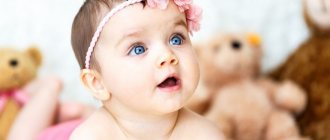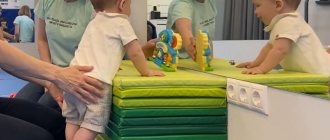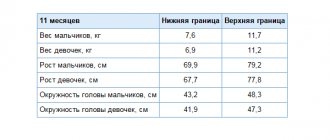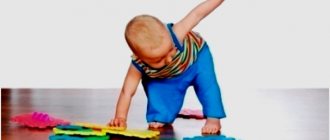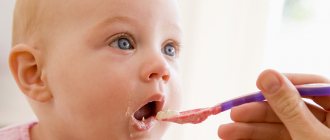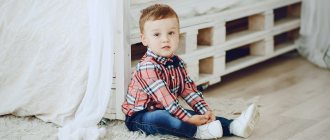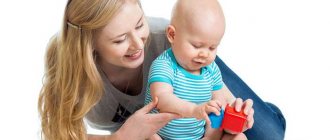Physical parameters per year and nine
Norms of height, weight, head and chest circumference for boys
- Height from 80.4 to 88.4 centimeters.
- Weight from 10.6 kg to 13.6 kg.
- Head circumference - 47.5 cm to 50.5 cm.
- Chest circumference – 48.8 cm to 52.0 cm.
Norms of height, weight, head and chest circumference for girls
- Height from 79.7 to 87.6 centimeters.
- Weight from 10.5 kg to 12.8 kg.
- Head circumference - 46.5 cm to 49.5 cm.
- Chest circumference – 47.7 cm to 51.9 cm.
Number of teeth
A child should have approximately 17 teeth , but according to WHO, their normal number is from 14 to 16 .
What can a baby do?
- overcome low obstacles, can climb onto a chair and onto a sofa independently;
- climb stairs holding the railing;
- build a tower or assemble a pyramid;
- distinguish the shape of objects, select the required shape for the sorter hole;
- determine the size of an object, for example, find the largest and smallest cube;
- distinguish colors, find two identical colors at the request of an adult;
- independently eat food of any consistency from a spoon, and also tries to bring it to the mouth with virtually no loss;
- put on a hat, pull up pants, put on shoes, undressing is even easier, easily takes off everything where it is not needed
- unfasten buttons and zippers;
- can use the potty consciously, communicating his needs in specific words;
- knows where toys are stored and, at the request of an adult, puts books and toys in their places;
- tries to be independent, begins to protest when he is offered help in something he wants to do himself.
Features of the psycho-emotional sphere
- The child is growing up every day, now he interacts with you in the game almost like an adult, because even those children who do not speak yet know how to express their emotions in some way.
- A baby of this age is balanced and calm, he is very interested in exploring the world, anxiety appears in an unfamiliar environment and when his mother is not nearby, although the child has become more independent, he still wants to always see his mother nearby.
- The emotionality of the baby is quite clearly expressed; he shows joy, interest, curiosity, playing with an adult or alone. When a baby, while playing on his own, tries to do something on his own, you will definitely notice by his reaction whether he succeeded in what he planned; if he starts screaming and crying, it means it didn’t work out, but if he’s happy and smiling, then everything was a success. The emotionality of a child is especially strongly influenced by the mood of an adult. The baby reacts very sensitively to your insult, sadness or joy.
- The child has become more sociable. He begins to communicate with other children, looking into their eyes, showing something with gestures and facial expressions.
Speech abilities
Most kids understand simple pictures very well, can show what is drawn there, and also answer the questions “Who is this?”
What is this? What is he doing?". Asking such questions after viewing illustrations or listening to a fairy tale is very useful, as it develops the child’s attention, memory, and thinking.
The children's vocabulary contains about 30-50 words. But there may be more. The sound is often simplified or uniquely individual.
Typically, a one-year-old and nine-month-old baby uses two-word sentences when communicating with an adult or playing.
The baby learned to fulfill requests - orders consisting of two actions. For example, “come to me, take the bear” or “pick up the ball and throw it to me.”
Every day the child remembers new words, and the formation of phrasal speech begins.
Neuropsychic development of a child at 1 year 9 months
At this age, many kids become very sociable and sociable, making contact with strangers easier.
Motor development of a child at 1 year 9 months
The baby has already mastered sufficient motor skills and can repeat simple movements after an adult. Therefore, at this age it is useful to do morning exercises with your child; this will help consolidate existing skills and strengthen the muscles and musculoskeletal system.
So at 1 year 9 months the baby can step over small obstacles, walk along a board or gymnastics bench.
He knows how to throw the ball into a basket standing on the floor not far from him.
Runs deftly in different directions, easily climbs onto a chair, sofa and also easily gets down to the floor.
Cognitive development of a child at 1 year 9 months
Knows how to play with simple construction toys, distinguishes and names primary colors. Knows several geometric figures. The baby is already able to distinguish and correlate the configuration of an object with the corresponding holes on the edge of the toy (developmental aid).
Knows such concepts as big, smaller, small.
Improves drawing skills - can draw straight and rounded lines.
Shows interest in peers and strives for interaction.
He can count to three and show on his fingers how old he is now.
In the game, the child begins to display life’s actions (cooking, washing, dressing, etc.). Can build a tower, path, table, chair and other simple buildings from cubes (after showing an adult).
Speech development of a child at 1 year 9 months
Confidently pronounces about 30 words. The speech still contains substitute words, simplified words. The baby tries to speak in simple sentences consisting of 2-3 words. Can engage in conversation with adults.
The baby can already understand a simple plot in a picture.
Can remember and complete two instructions. For example, take and put; take the toy and come to me and so on. Answers simple questions: Who is this? Where? Where?
At this age, speech development is very active, the baby accumulates new words, and phrasal speech is formed.
What can a child of 1 year 9 months do?
- The baby can now eat his favorite food on his own. He takes and bites off the bread himself.
- Able to independently pull off a hat and shoes (if they are easily removed).
- Makes attempts to dress and undress independently.
- Lets you know if he gets his hands or face dirty.
- He controls his physiological needs better and better, and can tell an adult when he wants to go to the toilet.
Intelligence
Intellectually, the baby is also progressing.
By this age, children are able to:
- distinguish the color, shape, size of an object;
- draw lines, geometric shapes, and also explain what you drew;
- identify animal voices and imitate them;
- recognize loved ones or acquaintances in the photo.
Reference! A child can be taught to pronounce his name, as well as learn with him the names of people close to him: mother, father, grandmother, grandfather, sister, brother.
How to play with a child at 1 year 9 months
At this age, games that involve matching objects by shape are very useful for a child’s development. Boxes of various shapes with lids, large puzzles, and special educational aids are great for this.
You can also offer your child games in which you need to sort objects by color and size.
To maintain the child’s interest, present educational activities in the form of a game. And don’t forget to praise your child for his efforts and diligence.
To develop speech, you need to read fairy tales, poems, nursery rhymes, and sing songs.
Finger games and games for developing fine motor skills are also useful at this age.
Let’s not forget “that life is movement,” so developmental activities should alternate with outdoor games.
Diet
Sample menu
The baby's menu should be varied and rich in vitamins.
- Breakfast (08:00) - milk porridge (semolina, rice, millet, wheat, Artek, rolled oats) with butter; bread (black, white) with butter and cheese; tea or cocoa with milk; apple.
- Lunch (11:30) – soup based on chicken or meat broth (with vermicelli, cereal, cabbage soup, borscht) with sour cream; mashed potatoes or vegetable stew and cutlet (sausages, meatballs, chicken, boiled fish) with gravy; fruit juice or dried fruit compote; bread.
- Afternoon snack (15:30) – boiled milk (ryazhenka, kefir, katyk, yogurt); bun (cookies, pie); fruit (pear, banana, orange).
- Dinner (18:00) – cottage cheese casserole (cheesecakes) with sour cream, milk or tea.
Recipe
Cottage cheese casserole
Ingredients needed to prepare the casserole:
- Cottage cheese 200 grams
- Sugar 3-4 tbsp. spoons
- Semolina 3 tbsp. spoons
- Egg 1 piece
- Butter (for greasing the pan)
- Sour cream 1 tbsp. spoon
- Vanillin
- Raisin
Cooking in the oven:
- Place the raisins in boiling water and leave while you prepare the other ingredients.
- Grind the cottage cheese thoroughly with a fork, beat in the egg and mix everything well.
- Add sugar, semolina and vanillin to the resulting mass, stir everything thoroughly.
- Rinse the raisins under running cold water, remove unnecessary tails and place in the curd mass.
- Prepare the mold by greasing it with oil.
- Pour the mixture into a baking dish, level it and pour sour cream on top.
- Place in a preheated oven and cook at 180 degrees for 30 minutes.
- Remove the casserole from the oven and garnish with fresh berries.
Bon appetit!
Features of hygiene and care
- Teach your child to follow good personal hygiene by teaching him other available self-care skills.
- Start your morning with regular exercise, then wash your face and brush your teeth.
- Let the child wash his hands under the tap, turn on the water, supervise, but do not limit his independence.
- You can’t bathe your baby every day, but before going to bed you need to wash him, it is advisable to rinse his feet with cool water (a hardening element).
Note! Put your baby on the potty, if he protests, don’t despair anyway and try to sit him down after sleep, at least 2 times a day.
Nutrition of a child at 1 year 9 months
The nutrition of a 1 year 9 month old baby is not very different from the nutrition of a one and a half year old child.
So, first and second courses must be present in a child’s diet.
For breakfast, porridge is still given, you can give an omelet or noodle casserole.
At this age, babies can be given pureed soups, borscht, meat and fish dishes, side dishes, mashed potatoes, vegetable stew, dairy and sour-milk products.
The diet must also include fresh fruits and vegetables, vegetable and animal fats.
Dairy and fermented milk products continue to maintain a leading position in a child’s diet.
A baby can drink up to 500 ml of kefir or milk per day. Cottage cheese can be offered in more complex dishes, for example, in the form of cottage cheese casseroles, lazy dumplings, cheesecakes.
The arsenal of vegetable dishes is expanding, so you can give your baby carrots, potatoes, cabbage, beets, pumpkin, and zucchini. You can offer your child a salad of fresh cucumbers and grated tomatoes.
The child needs meat dishes every day; it is better to give them in the first half of the day. Low-fat varieties of beef, veal, rabbit, and chicken are good for kids. Meat dishes can be in the form of meat purees, steam cutlets, meatballs, soufflés.
It is recommended to serve fish dishes 1-2 times a week.
Day and sleep routine
Approximate daily routine for children one year and nine months old:
- 7:00 – 9:00 – wake up, gymnastics, water procedures, breakfast
- 9:00 – 11:30 – games, walks, development activities
- 11:30 – 12:00 – lunch
- 12:00 – 15:00 – sleep
- 15:00 – 15:30 – afternoon tea
- 15:30 – 20:30 – games, walk (in summer), dinner
- 20:30 – swimming
- 21:00 – 21:30 - sleep
Daytime sleep occurs once for 2-3 hours, at night the child sleeps 10-11 hours. The total time for sleep per day is 12.5 -13.5 hours. Wakefulness lasts up to 5.5 hours.
Our website also contains materials about the following periods of babies’ lives: one year and 10 months, one year and 11 months.
Games
Children at this age are very active. They love to run and play tag. An equally exciting activity is studying objects, especially those that an adult uses. Preference is given to emotional games, such as hide and seek, where an adult actively uses facial expressions and changes his voice. Babies aged 1 year and 9 months enjoy expressive reading of fairy tales and rhymes.
What toys are interesting at this age:
- sorters;
- construction kits with large parts;
- simple puzzles;
- large puzzles of 4-8 elements;
- different types of vehicles (construction, fire, ambulance);
- plasticine, modeling dough, kinetic sand;
- mechanical spinning top;
- tolokar;
- matryoshka;
- tumbler;
- children's dishes, kitchen;
- magnetic fishing;
- jumping toys (large rubber animals, balls);
- figurines of people, animals, fairy-tale heroes;
- sketchbook, soft pencils, paints;
- outdoor toys (ball, sandbox set, wheelchair).
An independent game can last 15-20 minutes, with rare exceptions – longer. The baby still needs the attention of an adult, his tips, approval and admiration.
What can you play together?
- Find two identical objects. 5-6 types of fruits (different cups, machines, cubes) are placed on the table, all in single quantities, and a couple is added to only one variety. The child finds and shows which objects are the same.
- Day Night. The adult says “day” and together with the baby begins to actively run, stomp, and make noise. When the command “night” is given, it freezes and does not move.
- Repeat after me. The parent shows the movement: pat himself on the head, sit down, raise his hands up, clap his hands. The child repeats. The pace gradually increases. The game is played with music and is very fun.
Activities with your baby
Games
Knows how to build a tower from 4-5 cubes, assembles a pyramid from 3-4 rings, you can teach how to build a pyramid from two to three rings, taking into account the size.
Build the pyramid yourself, and then invite your child to do it. Ask him to find the largest and smallest ring.
Then say “first put the big ring, and then the small one”, monitor the child’s independent activity, do not immediately give a hint if he doesn’t succeed.
When all attempts are unsuccessful, then help your child by saying “first we put the big one, then the small one, don’t forget about it.”
During games with various educational sets, he remembers and distinguishes shapes such as circle, square, triangle.
Can select items of the same shape according to the proposed sample and at your request.
For example, you ask your child to find round objects from the given pictures.
If the child does not find it, then you can prompt him, then after some time ask him again, in this way he will gradually remember round-shaped objects and will distinguish them from square and triangular ones.
Children of this age can fit a smaller shape into a larger one. So he knows how to put bowls, cups, caps, and nesting dolls into each other.
Games with inserts are very useful. So, the baby can easily insert one or two figures into the corresponding holes.
But when a new manual appears, due to an insufficiently developed system of visual coordination, he often tries to insert inappropriate figures into the holes, but if you show him how to do it correctly, then he will remember it and can play independently.
Children's games are increasingly constructive in nature. The kid can already build a train by placing 3-4 cubes in a row.
Able to perform various actions on one toy. For example, brush, feed, put the doll to sleep.
The games are starting to show elements of story-based gaming.
Now the child doesn’t just roll the car around, teach him to put toy vegetables or fruits in the back and take them to the kitchen.
Also, in such games, the child easily replaces a real object with another, or even invents a non-existent one.
For example, he can carry a cube in the car, calling it a telephone, or feeds all family members non-existent porridge.
The kid knows how to hold a pencil and scribble within the boundaries of a sheet. If shown how to draw a line, he carefully repeats this action.
Loves to leaf through and look at books with colorful illustrations. Moreover, it turns over one page at a time, and not several, as before.
Finger games are very useful.
For example, the game “Family”, where family members are named and the child’s fingers are bent one by one.
For speech development, it will be very useful to read fairy tales to your baby, sing songs, read poems and ask him to repeat what he hears.
We recommend watching a video about ideas for games:
Toys
The most favorite toys of children at this age are still squeaking, talking, glowing and bright toys.
But they also love to play with collapsible toys, such as nesting dolls, pyramids, colorful cups, inserts.
Various construction sets with large parts and cubes are also very interesting for children.
Children love books with music and talking dolls.
Children of all ages enjoy interactive toys.
Note! Make sure that the toys are appropriate for the child’s age; do not leave the baby unattended with toys that have small parts.
Development norms
It is a rare child at 1 year and 9 months old who can boast of perseverance and calmness. This age is characterized by high physical activity, frequent changes of activities and mood. The baby is interested in everything new: toys, household items, food. He is attracted to pebbles and sticks and can still taste them. The concept “mine” appears. If previously it was not difficult to share your toy, now a fight can break out over a car or doll.
The child develops friendly connections among peers. True, joint play rarely begins; in general, sympathies are limited to emotional greetings and the exchange of toys. Children willingly join friends and play, although not together, but nearby.
At 1 year and 9 months, learning ability increases. The child quickly remembers colors, shapes, masters counting and even some letters. But if the material is not repeated, everything is forgotten very quickly. Approximately 80% of children at this age begin to feel a full bladder and bowels, and the process of emptying them becomes controlled.
Speech
At 1 year and 9 months, the child understands speech addressed to him well, pronounces not only syllables and sounds, but also words. Tries to construct simple phrases. While reading, he can repeat the endings of verses. Knows his name and says his name.
New speech skills:
- the interrogative form of words and phrases appears (“and this”, “who”, “which”);
- the child begins to comment on the game process, most of the words are of an unaddressed nature (“like this,” “yes,” “collect the cube,” “play”);
- speech stock increases to 20-50 words.
Words at this age are still pronounced unclearly and can be distorted and simplified (“dai lalya”, “di mama”, “yaboko”). Often, only a close adult can understand a child’s speech, and not without the help of intuition.
Physical development
Every day the child becomes more agile. His self-confidence increases. At 1 year and 9 months, girls weigh 9–12.5 kg, boys 1–1.5 kg more. Children's height ranges from 81 to 86 cm.
What are the physical skills of a child at this age?
- Climbing on and off a chair or a short ladder without the help of an adult.
- Passes along a wide crossbar.
- Steps over low objects.
- Runs without stumbling and avoiding obstacles.
- Handles a spoon quite skillfully, but sometimes gets dirty with food.
- Provides assistance when undressing, removes the headdress and shoes.
- Turns pages in a book.
- Can ride a tricycle.
Perception
At the age of one year and 9 months, the child interacts with the world around him no longer through mom and dad, but independently or with their help. He feels like a separate entity, but is still emotionally closely connected to the adult.
Characteristic features of perception:
- strive for independence, uses the pronoun “I” (“I myself”, “it’s me”, “I don’t want”);
- reacts to changes in the parent’s mood, behaves in a similar way (laughs, cries, gets irritated);
- seeks approval, responds to praise, is proud of himself;
- feels confident around close people, but shy around strangers;
- communicates with peers using facial expressions, gestures, can look into eyes, take hands;
- takes offense at prohibitions, may cry and be capricious in order to get his way;
- tries to understand the structure of toys, which often ends in their breakdown;
- understands the purpose of objects (if given a pen and paper, he will begin to draw, a shovel will begin to dig a hole).
Cognitive sphere
At 1 year and 9 months, thinking, memory, and attention continue to actively develop. If previously the baby used different options to perform the same action, now he can guess what and how to do to solve the task. The child can establish connections between objects experimentally.
A child at this age has the following skills:
- is able to perform a simple task (give a spoon, draw a circle, take off a hat);
- distinguishes colors and simple shapes (red-green, circle-square);
- shows body parts, at least 3;
- assembles a puzzle of 4-8 parts;
- puts the corresponding figures into the sorter;
- draws curved lines, circles, squares;
- can concentrate attention for 3-10 minutes.
You can often hear the statement that boys develop more slowly than girls. This is not entirely true. In girls, the left hemisphere, responsible for logical and verbal thinking, matures faster. But boys are leaders in the development of spatial-temporal orientation. They talk less but think outside the box. Boys have sharper hearing until about 8 years of age and lower skin sensitivity.
Tips for parents
- Give your child more opportunity to play in the fresh air, this is very useful for both intellectual and physical development;
- Do not leave your baby unattended on the playground when he is climbing a slide or running, do not rely on his independence, he is still too small;
- To help your baby get used to the potty faster, you can do this in a playful way, put a bear or doll on the potty, and then tell the child that now it’s his turn to sit on the potty, perhaps he will agree, children love to play;
- Do not indulge your child often and in any matter, otherwise he will constantly manipulate you, beg for candy, throw a tantrum in the store, clearly separate the boundaries of what is permitted, allowing the child something once, and then, by prohibiting it, you only make things worse for everyone;
- There is no need to stand by your principles; if a child wants to wear a blue jersey and not a yellow one, let him do so.
- Do not keep the TV on in the room all the time, even if the baby is distracted and does not watch it, otherwise he will simply get used to the fact that the TV should always be on. Make watching cartoons at a certain time for no more than 10 - 15 minutes;
- While walking, explore the world with your child, pay his attention to dogs, cats, trees, flowers. Communicate with your child, tell him what you know, also try to answer his questions without dismissing how busy you are; it is very important for your child to be answered and given attention.
